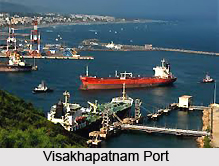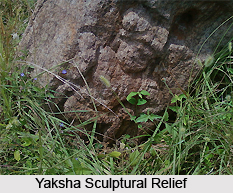 History of Visakhapatnam drifts back to the 3rd Century BC and evidences say that the origin of this city lies in the Buddhist ruins of Thotlakonda. Visakhapatnam is a coastal, port city in the Indian state of Andhra Pradesh, located on the eastern shore of India, amidst the hills of the Eastern Ghats and facing the Bay of Bengal to the east. It is the administrative headquarters of Visakhapatnam District and is also home of the Eastern Naval Command of the Indian Navy.
History of Visakhapatnam drifts back to the 3rd Century BC and evidences say that the origin of this city lies in the Buddhist ruins of Thotlakonda. Visakhapatnam is a coastal, port city in the Indian state of Andhra Pradesh, located on the eastern shore of India, amidst the hills of the Eastern Ghats and facing the Bay of Bengal to the east. It is the administrative headquarters of Visakhapatnam District and is also home of the Eastern Naval Command of the Indian Navy.
The defunct colonial British name of Visakhapatnam was Waltair. During the colonial era, the city had its hub at the Waltair railway station, and that part of the city is still called as Waltair. Visakhapatnam is sometimes also referred to as the "City of Destiny". According to 2007 population estimates, Visakhapatnam is said to be the 9th largest City in India. The city is home to several state owned heavy industries that is one of the most advanced steel plants in India and has one of the country`s largest ports and its oldest shipyard. Visakhapatnam has the only natural harbour on the eastern coast of India.
History of Visakhapatnam primarily relates it to the origin of its name. Visakhapatnam or the place of Visakha is named after the deity of valor, the second son of Lord Shiva. The other story related to the story of Visakhapatnam is the beauty of the place that was compared to the beauty of Sakhi Visakha. The legend is that Radha and Visakha were born on the same day and were equally beautiful. The city people believe that an Andhra King overwhelmed by the beauty built a temple to pay admiration to his family deity, Visakha. The stories associated with the history of Visakhapatnam are numerous but the fact remains that the unparalleled natural splendor of Visakhapatnam has been intact since its formation.
The Epic City or Visakhapatnam has been mentioned in the Indian epics Ramayana and Mahabharata. The forests of the Eastern Ghats; where the two brothers Rama and Laxman wandered in search of Sita, wife of Lord Rama. Rama formed his army of monkey men in the region with the help of Hanuman and Jambavan. The monkey army of Rama ultimately defeated the demon King Ravana and claimed back his wife Sita. An episode of Mahabharata when Bheema killed the demon Bakasura happened in the village Uppalam, just 25 miles from Visakhapatnam, as said in mythology.
 Buddhist influence in the history of Visakhapatnam has been noticeable. The religious Hindu texts mention that the region of Visakhapatnam in the 5th century BC was part of the enormous Kalinga territory, which extended up to River Godavari. The remnants found in the area also prove the existence of a Buddhist empire in the region. Kalinga later surrendered their territory to King Ashoka in the bloodiest battle of the time, which encouraged him to embrace Buddhism. The territory of Viskahapatnam was then taken over by the Andhra Rulers of Vengi. Then Chalukyas, Pallavas, the Reddy Kings ruled over the placid land and formed a compact history of Visakhapatnam.
Buddhist influence in the history of Visakhapatnam has been noticeable. The religious Hindu texts mention that the region of Visakhapatnam in the 5th century BC was part of the enormous Kalinga territory, which extended up to River Godavari. The remnants found in the area also prove the existence of a Buddhist empire in the region. Kalinga later surrendered their territory to King Ashoka in the bloodiest battle of the time, which encouraged him to embrace Buddhism. The territory of Viskahapatnam was then taken over by the Andhra Rulers of Vengi. Then Chalukyas, Pallavas, the Reddy Kings ruled over the placid land and formed a compact history of Visakhapatnam.
The Chola Kings built the temples in Visakhapatnam during the 11-12 century AD as established by Archeological remnants. The Mughals ruled Visakhapatnam under the Hyderabad Nizam in the late 15th and early 16th century. The merchants from Europe, the French, the Dutch and the East India Company also utilised this natural port to export tobacco, ivory, muslin and other important textile products.
Local legend states that an Andhra king, belonging to the 9-11th century, while on his way to Varanasi, rested in Visakhapatnam and was so enchanted with the tranquil beauty of the place, that he ordered a temple to be built in honor of his family deity, Visakha. Archaeological sources however reveal that the temple was possibly built between the 11th and 12th centuries by the Cholas. Sankarayya Chetty, a shipping merchant, built one of the mandapams or the pillared halls of the temple. Although it no longer exists, history of Visakhapatnam says many stories of its glorious past.
In the 18th century, Visakhapatnam was included in the Northern Circars, a region comprising Coastal Andhra and southern costal Orissa that was initially under French control and later the British. Visakhapatnam became a district in the Madras Presidency of British India. After India`s independence, Visakhapatnam was the biggest district in the country and was subsequently divided into the three districts of Srikakulam, Vijayanagaram and Visakhapatnam.
The history of Visakhapatnam has witnessed the growth of the massive industrial sectors, owing to the presence of the Eastern Naval Command, Steel Plant, H.P.C.L. Visakhapatnam has been the home to people from different parts of the country and thus the city has a cosmopolitan texture to it. The history of Visakhapatnam speaks of the city`s growth from a sheer tranquil patch of land to one of the most important harbours and industrial hubs in the nation.



















